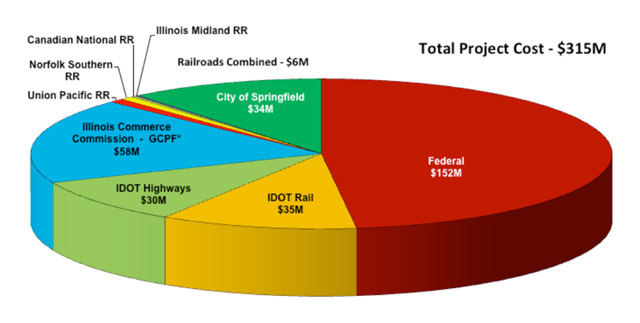Why is the Springfield Rail Improvements Project being conducted?
The City of Springfield is undertaking the Springfield Rail Improvements Project to address issues of public safety, traffic congestion, community livability and commercial development. With regard to public safety, there are currently 68 at-grade rail crossings and 24 miles of unfenced right-of-way throughout the project area. At-grade crossings, create conflict points for cars, trains and pedestrians that can result in train-vehicle collisions, personal injury and death, reduced train and vehicular speeds, and increased congestion. Overall, they jeopardize public safety and lengthen travel times.
Data collected on traffic delays caused by at-grade crossings indicate that Springfield’s traffic congestion issue is worsening. Vehicle delays due to trains blocking crossings are projected to more than triple, from 13,800 vehicle-minutes per day today to 47,500 vehicle-minutes per day in 2030. These values were calculated from train and vehicle traffic projections, with both car and train traffic projected to grow considerably in the intervening years.
In addition to increased delays, more train traffic promises to generate considerably more noise if unmitigated. Train horns must be sounded at all public crossings to warn motorists and pedestrians when a train is approaching, 24 hours a day. At present, each of the city’s rail lines is beset by noise from train horns. However, this project will eliminate train horns between Stanford Avenue and Sangamon Avenue.
Along with creating a quiet zone, this project will – through rail consolidation – also remove some of the barriers to commercial activity and residential connectivity presented by the large number of train tracks that crisscross Springfield.
What will occur during the Springfield Rail Improvements Project?
The Springfield Rail Improvements Project involves planning and design, land acquisition and construction. The project is being conducted in usable segments with each segment focused on design, land acquisition, and construction. Survey work and soil borings have already been completed. The survey work determines existing right-of-way and property line locations within the project area. Soil borings were collected from publicly owned property, such as streets and alleys. These borings test the underlying soil and rock for the design of pavements, track and bridge foundations.
The Carpenter Street underpass (Usable Segment 1) was under construction in September 2014 and is expected to be complete in the spring of 2016. The Tenth Street corridor will be upgraded in segments as funding becomes available. The second segment will most likely be Usable Segment 2, including the Ash and Laurel Street underpass at Tenth Street. The City has applied for a federal TIGER grant to build these underpasses. If successful, construction could begin in 2016. Currently, there is no funding for land acquisition or construction of any additional segments
How much does the project cost and who is paying for it?The Illinois Department of Transportation (IDOT) is paying $8.65 million for the first phase of the project, which includes planning and design. The entire project, however, is estimated to cost $315 million and would involve a wide range of funding sources. A conceptual funding plan was prepared to identify how much might be required from the various project partners. These amounts are likely to change and actual funding requirements will be determined as the project moves forward. The largest funder would likely be the federal government followed by IDOT, the Illinois Commerce Commission, the City of Springfield, and the affected railroad companies. See the accompanying pie chart.





